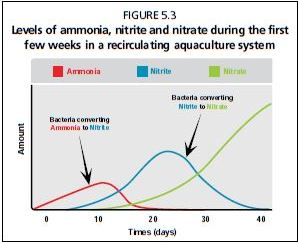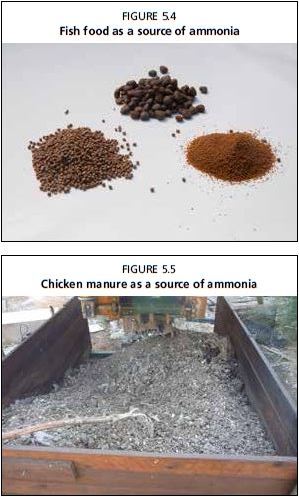5.4 SYSTEM CYCLING AND STARTING A BIOFILTER COLONY
System cycling is a term that describes the initial process of building a bacterial colony when first starting any RAS, including an aquaponic unit. Under normal circumstances, this takes 3-5 weeks; cycling is a slow process that requires patience. Overall, the process involves constantly introducing an ammonia source into the aquaponic unit, feeding the new bacterial colony, and creating a biofilter. The progress is measured by monitoring the nitrogen levels. Generally, cycling takes place once an aquaponic system is built, but it is possible to give the biofilter a head start when creating a new aquaponic system.
It is important to understand that during the cycling process there will be high levels of ammonia and nitrite, which could be harmful to fish. Also, make sure all aquaponic components, in particular the biofilter and fish tank, are protected from direct sunlight before starting the process.
Once introduced into the unit, the ammonia becomes an initial food source for the AOB, a few of which are naturally occurring and recruit to the system on their own. They can be found on land, in water and in the air. Within 5-7 days after the first addition of ammonia, the AOB start forming a colony and begin to oxidize the ammonia into nitrite. Ammonia should be continuously, but cautiously, added to ensure adequate food for the developing colony without becoming toxic. After another 5-7 days the nitrite levels in the water will have started to rise, which in turn attracts the NOB. As the NOB populations increase, the nitrite levels in the water will start to decline as
FIGURE 5.3
few weeks in a recirculating aquaculture system

nitrite is oxidized into nitrate. The full process is Levels of ammonia, nitrite and nitrate during the first illustrated in Figure 5.3, which shows the trends of ammonia, nitrite and nitrate in the water over the first 20-25 days of cycling.
The end of the cycling process is defined as when the nitrate level is steadily increasing, the nitrite level is 0 mg/litre and the ammonia level is less than 1 mg/litre. In good conditions, this takes about 25-40 days, but if the water temperature is cool, complete cycling may take up to two months to finish. At this point, a sufficient bacterial colony has formed and is actively converting the ammonia to nitrate.
The reason this process is long is because nitrifying bacteria grow relatively slowly, requiring 10-15 hours to double in population. However, some heterotrophic bacteria can double in as little as 20 minutes.
Aquarium or aquaculture retailers sell various products containing living nitrifying bacteria (in a bottle). Once added to the unit, they immediately colonize a system thus avoiding the cycling process explained above. However, these products may be expensive or unavailable and ultimately unnecessary, as the cycling process can be achieved using organic means. Alternatively, if another aquaponic system is available, it is extremely helpful to share part of the biofilter as a seed of bacteria for the new system. This greatly decreases the time necessary for cycling the system. It can also be useful to separately start a biofilter medium by continuously trickling a solution containing 2-3 mg/litre of ammonia for a few weeks in advance. The media would then function as a primer by simply incorporating it into the new aquaponic biofilter. A simple trickling system can be built by suspending a wide plastic crate of medium above a small tank containing the ammonia solution that is being circulated by a small aquarium pump.
Many people use fish as the original source of ammonia in a new tank. However, these fish suffer the effects of high ammonia and high nitrite throughout the cycling process. Many new aquarists do not have the patience to allow a tank to fully cycle and the result is that the new fish die, commonly referred to as "new tank syndrome". If using fish, it is recommended to use a very low stocking density (≤ 1 kg/m3). Instead of using fish, there are other sources of this initial ammonia to start feeding the biofilter colony. Some possible sources include fish feed, sterilized animal waste, ammonium nitrate fertilizer and pure ammonia. Each of these sources has positives and negatives, and some sources are far better and safer to use than others.

FIGURE 5.4
Fish food as a source of ammonia
FIGURE 5.5
Chicken manure as a source of ammonia
The best ammonia source is finely ground fish food because it is a biologically safe product, and it is relatively easy to control the amount of ammonia being added (Figure 5.4). Be sure to use fresh, unspoiled and disease-free fish feed only. Chicken waste, despite being an excellent ammonia source, can be very risky and can introduce dangerous bacteria into the aquaponic system (Figure 5.5). Escherichia coli and Salmonella spp. are commonly found in chicken and other animal manure and, therefore, any manure must be sterilized before use. Household ammonia products can be used, but be sure that the product is 100 percent ammonia and does not include other ingredients such as detergents, colourants or heavy metals that could ruin the entire system. Once the ammonia source has been selected, it is important to add the ammonia slowly and consistently, and to monitor the nitrogen levels every 2-3 days (Figure 5.6). It is useful to record levels on a graph to track the process of the cycling. It is important not to add too much ammonia, and it is better to have a little bit too little than too much. The target level is 1-2 mg/litre. If ammonia levels ever exceed 3 mg/litre, it is necessary to do a water exchange to dilute the ammonia in order to prevent it from inhibiting the bacteria.
5.4.1 Adding fish and plants during the cycling process
Plants and fish should be added only after the cycle is complete. Plants can be added a little bit earlier, but expect nutrient deficiencies in these early plants during this period because other nutrients take time to reach optimal concentrations (Figure 5.7).
Only once the ammonia and nitrite levels are below 1 mg/litre it is safe to start stocking the fish. Always start stocking the fish slowly. Once fish have been stocked, it is not uncommon to see a secondary and smaller ammonia and nitrite spike. This happens if the ammonia created from the newly stocked fish is much greater than the daily ammonia amounts added during the cycling process. Continue to monitor the levels of all three types of nitrogen, and be prepared to do water exchanges if ammonia or nitrite levels rise above 1 mg/litre while the system continues to cycle.